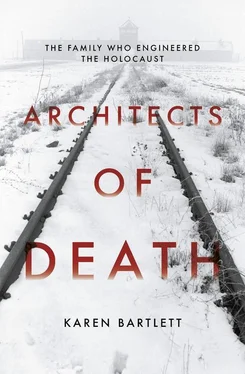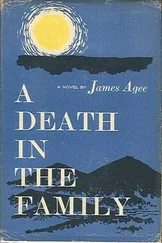His Topf colleagues, Wilhelm Koch and Martin Holick, were installing the three-muffle ovens in Crematorium II from September 1942 onwards. Koch spent a total of nine months at Auschwitz, during which time he installed the waste incinerator in Crematorium III and the ovens in Crematoria IV and V. Martin Holick spent a year at Auschwitz, completing the construction of the ovens in Crematorium II, and the installation of the fumigators in the ‘sauna’. A fourth fitter, Arnold Seyffarth, was dispatched to complete the ovens in Crematorium III, and stayed for several months.
These four men enjoyed a high status in the company, and in the camp. Although they may have exercised no control over their assignment, none of them used their advantageous position within the company to sabotage projects or oppose their work. They lived in comfortable SS accommodation during their stay, and were some of the 1,000 civilian workers on site who were cut off from the outside world during the typhus epidemic that occurred in the last months of 1942. ‘The mass extermination carried out at Auschwitz-Birkenau cannot have escaped their notice,’ Annegret Schüle writes. ‘The flames from the incineration of tens of thousands of piled-up corpses were visible for miles around.’ [91] Schüle, op. cit., p. 196. ‘The flames from the incineration were visible for miles around.’
Kurt Prüfer, Karl Schultze and the Topf fitters were the men on the ground, and on 5 March 1943, the day finally came to try out the new ovens for Crematorium II. As predicted, the construction unit was running one month behind schedule, and that morning prisoners in the special unit (responsible for operating the crematoria and gas chambers) had been instructed by Prüfer to start heating the ovens early so that they could be operating at maximum efficiency later in the day. At about 4 p.m., a delegation of senior SS officers from Berlin, members of the political department and representatives from Topf and Sons drove up to the crematorium and took their places as the demonstration began.
Henryk Tauber, a prisoner in the special unit, described what happened next: ‘Once the committee had arrived, we were ordered to fetch bodies from the morgue and throw them in the [muffle ovens].’ In the morgue Tauber found the bodies of a large group of well-fed men, who had been gassed earlier in Bunker II. These men, with a higher proportion of body fat, had been specially requested by Prüfer to test the operating performance of the crematorium. ‘Once all the bodies had been distributed across all the chambers of the five ovens, the committee members observed the process, holding their watches in their hands. They opened doors, looked at their watches, talked among themselves and expressed surprise that the cremation had taken so long.’ [92] Schüle, op. cit., p. 27. AS footnote 178: Piper, Vernichtung , p. 286f [Bibliography lists a number of books by Piper, Franciszek, but none with Vernichtung [extermination or annihilation] as the key word in their title.]
Prüfer and his colleagues from Topf and Sons were surprised and dismayed. But these emotions were not provoked by the fact they had just witnessed such a horrific event; rather they were disappointed that the ovens, which had been heated since early morning, still had not reached the optimal temperature, and the cremation of one load of bodies had taken forty minutes. Initially, Prüfer had estimated that two full loads could be cremated every hour. Tauber added that ‘senior overseer August told us that the calculations and plans for the crematorium had allowed 5–7 minutes per corpse.’
Annegret Schüle estimates that at the rate of three bodies per muffle every half hour, Crematoria II and III would have been able to cremate a maximum of 2,160 bodies per day, a figure that roughly tallies with one given by Rudolf Höss (the total cremation capacity across all of Auschwitz-Birkenau was 8,000 bodies over twenty-four hours). The SS was initially delighted with the ‘highly efficient’ running of the new crematorium, and commented on the reduction in coke consumption as a result of the continual use of the ovens. ‘These are outstanding figures!’ wrote one civilian working for the SS in March 1943. [93] Schüle, op. cit., p. 209 – efficiency of the crem – these are outstanding figures writes the SS. AS footnote 193: ThHStAW, Collection Jean-Claude Pressac Nr 42, sheet 212, and Buchenwald Memorial Archive, Pressac Collection, sheet 875.
In reality, the ‘efficiency’ of the mass murder at Auschwitz-Birkenau was often derailed by a combination of unrealistic demands from Berlin, and the reliability of the people who worked in the crematoria on a day-to-day basis. These prisoners from the special unit had two compelling motivations: to keep themselves alive and make that life as bearable as possible. One way to do this was to shove four or five bodies into a single muffle to give themselves a break between cremations – but this increased the wear and tear on the ovens and led to repeated breakdowns, something that would strain the relationship between Topf and Sons and the SS.
Another strain was that while the ovens at Crematorium II had now been completed, work on the gas chamber had fallen behind schedule.
Topf fitter Heinrich Messing accumulated thirty-five hours of carefully recorded overtime, during the week beginning Monday 8 March 1943. Messing’s job was to install the ventilation technology for the gas chamber and the undressing room in the cellar of Crematorium II. Although these were referred to officially by the SS as morgues I and II, Messing preferred to use the term ‘undressing room’ in his own notes, demonstrating that he understood the process, and the true nature, of the crimes planned for that location. As Annegret Schüle puts it, he was installing technology that would facilitate the ‘speedy suffocation of hundreds of thousands of people’. [94] Schüle, op. cit., p. 209. The sentence at the start of this paragraph makes it clear that the info comes from ‘the Topf fitter Heinrich Messing’s timesheet for the period from 8 Monday to 14 Sunday March 1943’.
Topf’s ventilation expert, Karl Schultze, was also working at Auschwitz during that same week, and tested the blower (the forced draught system) for the ovens on Crematorium II on Wednesday 10 March.
On Saturday 13 March, it was time to test the blower and the ventilation system for the gas chamber itself. On that day 1,492 Jews from the Kraków ghetto were transported to Birkenau to be murdered. The SS had recommended that the ovens should be working when the blower system was tested, as this was when temperatures were at their highest. That evening when the group arrived, the SS then selected between 150 and 300 men, women and children, and gassed them to death. The bodies were then moved upstairs to be burned in the ovens. During his interrogation by the Soviets, Karl Schultze disclosed the details of what happened:
At the moment when the SS people drove them into the gas chamber, I was in the crematorium, in the vicinity of the crematorium ovens. The bodies of these prisoners were burned in my presence. Once the killing of these prisoners in the gas chambers had been completed (which took no longer than fifty minutes) an SS man switched on the ventilation systems, with the help of which the contaminated air was extracted and fresh air blown in. [95] Karl Schultze’s Soviet interrogation record, Landesarchiv Thüringen - Hauptstaatsarchiv Weimar.
This test showed that the ventilation system and blower were ‘working perfectly’, according to Schultze, and he returned immediately to Erfurt. Upon his return to Topf and Sons, Schultze ‘gave Ludwig Topf a report on the work I had done in connection with the testing of the blower and ventilation systems in the second crematorium. As an aside, I informed him that the SS people had killed a group of prisoners in the gas chambers and that their bodies were then burned in the cremation ovens. L. Topf did not react to this.’ [96] Ibid.
Читать дальше












